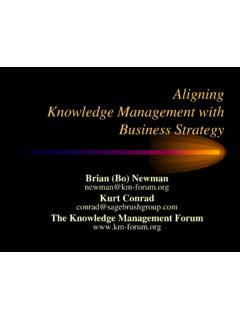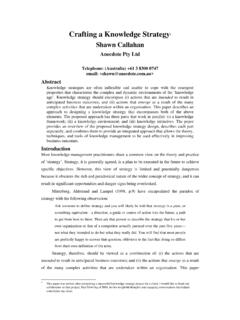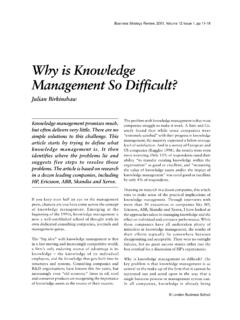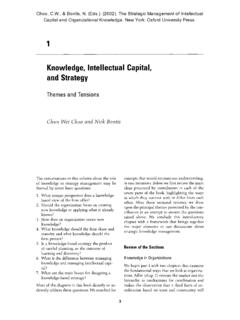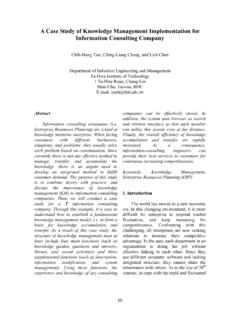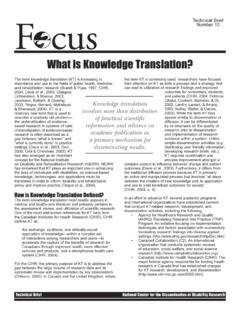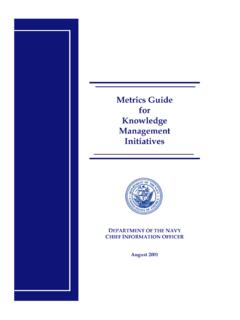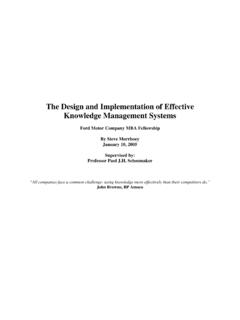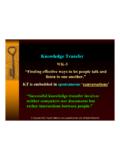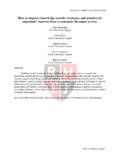Transcription of FAO Knowledge Strategy
1 FAO Knowledge Strategy March 2011 ii FAO Knowledge Strategy OVERVIEW OF THE Strategy BACKGROUND .. 1 Why does FAO need a Knowledge Strategy ? .. 1 Dialogue with Member States .. 1 Articulating the Strategy .. 1 Inputs from the FAO Reform Process .. 2 Lessons Learned from Other International Organizations .. 3 Knowledge as an FAO Core Function .. 4 THE FAO Knowledge Strategy .. 5 Vision, Mission and Objectives .. 5 Strategic Principles .. 5 ROADMAP FOR IMPLEMENTATION .. 8 One Integrated Roadmap .. 8 Two Specific Change Objectives .. 8 PROPOSED CHANGE OBJECTIVES .. 8 Support to Three IPA Projects as Entry Points .. 9 Four Steps to Launch the Strategy .. 10 BUILDING MOMENTUM AND ENSURING PROGRESS .. 12 Leadership and Coordination .. 12 Monitoring and Evaluation .. 13 HOW TO LEARN MORE AND PARTICIPATE.
2 13 ANNEX 1: FAO Knowledge TERMINOLOGY .. 14 ANNEX 2: SUMMARY OF STRATEGIC PRINCIPLES .. 16 ANNEX 3: SUMMARY OF SHORT-TERM ROADMAP .. 18 ANNEX 4: ILLUSTRATIVE CASE STUDIES FROM THE Knowledge SHARE FAIR, JANUARY 2009 .. 19 Case Study 1: Food and Nutrition Security Community of Solution Exchange .. 19 Case Study 2: National Programmes for Food Security .. 20 Case Study 3: Smallholder productivity improvement in water management , agriculture, livestock and aquaculture through FAO s South-South Cooperation Programme .. 20 Case Study 4: Rural Communication Systems .. 21 Case Study 5: The Urban Forest Community .. 22 Case Study 6: Fishery Resources Monitoring System Partnership .. 22 Case Study 7: The Integrated Food Security Phase Classification .. 23 Case Study 8: E-learning to Support Knowledge Sharing .. 23 Case Study 9: Plant Production and Protection Division (AGP): One Global AGP.
3 23 ANNEX 5: REFERENCES AND RESOURCES .. 25 Strategy Working Papers .. 25 Member State and Other Guidance Documentation .. 25 Other FAO Resources .. 26 Knowledge management Strategies of Other Development Organizations .. 26 Concepts and Good Practices in Knowledge management .. 27 iii ACRONYMS CEB - United Nations System Chief Executives Board for Coordination CIO - Chief Information Officer CoC-IEE - Committee of the Conference for the follow-up to the Independent External Evaluation of FAO DDG - Deputy Director-General FAO - Food and Agriculture Organization of the United Nations FI - Fisheries Department FO - Forestry Department HLCP - High-level Committee on Programmes of the United Nations System Chief Executives Board for Coordination HR - Human Resources ICTs - Information and communication technologies IEE - Independent External Evaluation of FAO IPA - Immediate Plan of Action for implementation of the IEE JIU - Joint Inspection Unit KCE - Knowledge Exchange & Capacity Building Division KCI - Communication Division KCT - Information Technology
4 Division LDC - Least-developed Country MTP - Medium-Term Plan OCD - Office for Coordination and Decentralization OEK - Office of Knowledge Exchange, Research and Extension PBE - Office of Programme, Budget and Evaluation PEMS - Performance Evaluation management System PWB - Programme of Work and Budget RBM - Results-Based management RR - Regional Representative SIDA - Swedish International Development Cooperation Agency FAO Knowledge Strategy Page 1 of 27 BACKGROUND Why does FAO need a Knowledge Strategy ? 1. Knowledge1 is one of the primary tools in FAO s fight against hunger and poverty. The Director-General highlighted this when he introduced the concept of FAO as a Knowledge Organization in his reform proposals beginning in The subsequent Independent External Evaluation (IEE) devoted considerable attention to the role of information and Knowledge in FAO s current and future mission.
5 2. The IEE made a compelling case that FAO risks marginalization unless it fully exploits its comparative advantages as multidisciplinary integrator, convener and neutral forum to promote greater access to and flow of Knowledge . There are now many centers of excellence producing high-quality information and Knowledge in FAO s areas of mandate, and the Organization risks progressive irrelevance unless it asserts and develops its capacities for partnership and facilitation in support of access to and flow of Knowledge among and flow between all stakeholders. 3. Furthermore, FAO s ability to perform effectively is also very much at stake. Knowledge sharing concepts, methods and tools can make a vital contribution to the broad goal of making FAO more efficient, innovative and relevant. A failure to take all possible steps towards this goal will accelerate the process of marginalization.
6 Dialogue with Member States 4. In 2008, a discussion on Knowledge was initiated with Working Group 1 of the Committee of the Conference for the follow-up to the IEE (CoC-IEE).3 A concept note on corporate Knowledge management was prepared by the Knowledge Exchange and Capacity Building Division (KCE) and discussed in February 2008, leading to the drafting of a Strategy Note on Corporate Knowledge management which was reviewed with comments by the Working Group in April 2008. This Strategy Note and the CoC-IEE s feedback represent the conceptual starting point for FAO s Knowledge Articulating the Strategy 5. In August 2008, resources from the Programme of Work and Budget (PWB) 2008-09 plus additional resources from the Swedish International Development Cooperation Agency (SIDA) were provided to support further development of the Strategy .
7 There were three objectives with respect to the April 2008 Strategy Note: a) Validation. To perform additional research and consultation to confirm essential findings and recommendations; b) Elaboration. To develop the recommendations in more detail and make the conceptual and practical framework more robust; and c) Contextualization. To ensure appropriate integration of the Strategy with other elements of the Immediate Plan of Action (IPA), including FAO s new Strategic Framework, which were developed and presented to the CoC-IEE in 2008 and 2009. 1 In this Strategy , simple, jargon-free definitions have been adopted for information and Knowledge , after Collison and Parcell, Learning to Fly, Capstone Publishing, 2004, See Annex 1 for a brief discussion and illustrative case study.
8 2 A review of one of the Director-General s key initiatives, Thematic Knowledge Networks (TKN), contributed directly to the initial formulation of the Strategy . 3 In addition, a seminar on Knowledge exchange and capacity development was held for Permanent Representatives in January 2008. 4 Links to the Strategy Note and the CoC-IEE feedback are provided in Annex 5. FAO Knowledge Strategy Page 2 of 27 6. The work was approached in three phases and was documented in a series of Working Papers as illustrated in the figure below. 5 Review of IEE & Other Reform Documentation(Working Paper 1) Strategy Framework & Principles(Working Paper 4)How Information & Knowledge Add Value in FAO's Programme & Partnerships(Working Paper 5) Continuous Improvement through Knowledge Sharing & Learning(Working Papre 6)Finding the Synergy between People, Process & Technology(Working Paper 7)Roadmap for Implementation(Working Paper 8)Analysis of Information and Knowledge as an FAO Core Function (Working Paper 3)Phases and Working PapersReview of KM Strategies of Other Int'l Development Organizations(Working Paper 2)FAOK nowledge StrategyPhase 1: Background, Context, ObjectivesPhase 2: FAO Experience and PrioritiesPhase 3: The Change AgendaReview of Thematic Knowledge Networks 7.
9 The first phase, which took place from September 2008 through the end of January 2009, focused on background surveys including: Member State inputs through the IEE and the FAO reform processes in general; a review of the experiences of other international organizations; and the overall programmatic context for information and Knowledge as an FAO core function. This phase culminated in a set of ten strategic principles for information and Knowledge , which were presented at the Knowledge Share Fair held at FAO in January In turn, the submissions and sessions of the Knowledge Share Fair contributed highly relevant case studies and lessons learned for the Strategy , examples of which are presented in Annex 5. 8. The second phase, which took place from February through June 2009, involved a series of consultations within FAO and with key partners to assess the strengths and weaknesses of FAO s methods of delivering Knowledge services and using Knowledge sharing techniques to improve its performance.
10 This phase resulted in a roadmap of specific interventions to operationalize the principles established in Phase 1. 9. The third phase, completed between July and September 2009, consolidated the preceding work into documentation, including this Summary, as a basis for communication and engagement with FAO staff and managers, Member States and partners. Inputs from the FAO Reform Process 10. As basic background to the FAO Knowledge Strategy , an in-depth review was conducted of key documents related to FAO reform, the IEE, reviews by the Joint Inspection Unit (JIU) and other relevant sources of perspective and The main findings of this review were as follows: a) FAO s role as facilitator of access to and flow of Knowledge . A recurring theme is that the Organization is well positioned to promote and facilitate the flow of global Knowledge in agriculture not just its own Knowledge assets and this role should be given increased priority.










